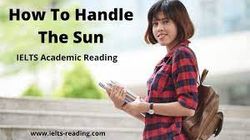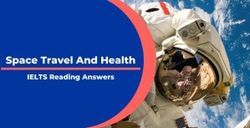Aug 14, 2022
IELTS READING : How to handle the Sun



PASSAGE 1 TITLE : How to handle the Sun
A.
1-The medical world appears to be divided on the effects of the sun upon the human body. From statements like, “There is no known relationship between a tan and health” to “perhaps sun-tanned skin absorbs the ultraviolet rays and converts them into helpful energy”, there are some things which are still the topic of research. Doctors agree on one of the benefits of the sun – vitamin D.
2- It is well known that vitamin D is acquired from the direct rays of the sun – an entirely separate miracle from sun tanning. The sun’s ultraviolet rays penetrate only a tiny amount into the human skin, but in the process, they irradiate an element in the skin called ergosterol, which is a substance that stores up reserves of vitamin D received from the sun. This is both healthy and beneficial for human skin.
B.
1- All around the Western World, people have developed an obsession with the sun. In many western countries, a suntan has become the trade-mark of a healthy, active, outdoor person. The basic reddish hue just beneath the surface of our skin is the outward reflection of the millions of red corpuscles flowing through tiny blood vessels.
2- This is most noticeable in the pure skin of a baby which can change in a moment from porcelain white (with anger or a switch in temperature) to crimson. In Caucasians, this colouring is somewhat hidden by an acquired layer of sun-made pigment, which varies in tone according to the complexion and occupation of the individual.
C. Locale plays a big part in the effectiveness of the suntan. Mountain tops and beaches are nonpareil sun spas because they receive far purer sunlight than the rest of the land. Urban areas with their smoke and smog act as a filter removing all the healthy properties of the sun. Perhaps the seashore is best of all, with its air estimated to have at least a fifth of a per cent more oxygen than inland ether – free of city and inland dust, tars, pollen, and allergens.
D.
1-The sun has long been called nature’s greatest health giver and healer and has played a chief role at health resorts ever since August Rollick, the Swiss father of heliotherapy, opened his first high-Alps sanatorium in 1903. Dr. W. W. Coblenz suggests that the sun cure is a major factor in the treatment of at least 23 skin diseases, ranging from acne and eczema to ulcers and wounds.
2- Another specialist, Dr. Richard Kovacs writes, “Sun treatment is often helpful to persons suffering from general debility – repeated colds, respiratory diseases, influenza and the like”. After a long winter, the return to the sun writes Dr. Leonard Dodds, the British sunlight scholar, “is a general stimulus to the body, more potent if applied after a period when it has been lacking which gradually loses its effect if exposure is over prolonged, even when not excessive”.
E.
1- Over many years of study, dermatologists have proven that excessive exposure to sunlight for years is responsible for a large proportion of skin cancer amongst the population. Those with the greatest chance of doing permanent damage to their skin are the year-round outdoor workers – 90% of which occurs on the heavily exposed hands and face. The first line of defense against permanent sun damage is the skin’s own natural fatty matter and sweat, which combine to form an oily acid surface shield against the ultraviolet rays.
2- At the beach, the saltwater washes away this natural oily coat, the hot sun overworks the sweat glands so that the excess becomes ineffective and the dry wind and hot sun combine to dehydrate the skin itself. Over the years, women have shown far greater wisdom in the care of their skin than men. Since the ladies of ancient Egypt first began to apply the fat of the so-called sacred temple cats to their faces, women have been tireless in waging this battle against damage to the skin from the sun. Both sexes now contribute annually to a multi-million dollar global sunscreen business.
F.
1- Other pans of the human body which tend to suffer from exposure to the sun are the eyes and hair. Many years ago, optometrists undertook studies in America to examine the influence of the sun upon the eyes by studying Atlantic City lifeguards and found that even a few hours in the bright sun without sunglasses could cause a significant loss of vision – a loss that might take several weeks from which to recover.
2- So gradual was the change that the lifeguards were unaware that their sight had been affected. The solution to this problem was to introduce sunglasses as a standard part of the lifeguard uniform. These were dark enough to absorb the sun’s harmful UV rays and most of its infrared and ultraviolet rays.
G. Of a lesser impact is the effect of the sun upon the hair. The penalty of the sun parching is a brittle dryness. Haircare professionals recommend a nutritional cream treatment with a substance containing lanolin to bring your hair back its natural softness, these usually come in the form of leave-in conditioners, and should be applied frequently, just as you would a sunscreen for the skin. Or, easier still, wear a hat. Wearing a hat has a dual effect: it protects the hair and helps to prevent the most dangerous of outdoor afflictions: sunstroke.
Question 1-4
Look at the following people (Questions 1-4) and the list of statements below.
Match each person with the correct statement.
1. Richard Kovacs 1
Answer: E
2. August Rollier 2
Answer: H
3. W. Coblenz 3
Answer: C
4. Leonard Dodds 4
Answer: F
A. believes that the benefits of the sun are not scientifically provable
B. claims to have discovered the vitamin released in the skin by the sun
C. suggests that the sun is an excellent healer
D. invented the first sunscreen
E. suggests that the sun assists with common illnesses
F. thinks that initially, the sun is of benefit to the body
G. is unsure about the benefits of the sun
H. thinks the location is very important in maximizing the benefit from the sun
Question 5-9
Do the following statements agree with the information given in Reading Passage?
TRUE – if the statement agrees with the information
FALSE – if the statement contradicts the information
NOT GIVEN – if there is no information on this
5
Most doctors agree when it comes to the health benefits of the sun.
Answer: FALSE
6
Beaches are best for a suntan because the air has far less pollution.
Answer: TRUE
7
Women applied fat to their skin for protection from the sun.
Answer: TRUE
8
Extended exposure of the eyes to the sun can lead to blindness.
Answer: NOT GIVEN
9
The human eye cannot heal itself when it is damaged by the sun.
Answer: FALSE
Question 10-14
Complete the summary using the words from the box.
Handling the Sun:
Many doctors agree that skin cancer can be caused by excessive exposure to the sun. As far as the human body is concerned, it is primarily the face and hands that are 10
Answer: AFFECTED. When human skin is exposed to the sun, the body has a defense: an 11
Answer: BLEND of the skin’s natural oils and acids. For some time, women have been more effective than men in 12
Answer: CARING for their skin. Eyes are a significant part of the body that are negatively affected by the sun.
The damage often goes undetected because it happens quite 13
Answer: SLOWLY On the other hand, hair becomes quite dry and brittle when exposed to the sun for an extended period. A lanolin-based conditioner is recommended by hair care professionals to 14
Answer: OVERCOME this problem. Perhaps a simple hat may be the best solution for hair.
overcome maintaining
located mixed
quickly extended
prolonged blend
arrangement succeed
combined surprisingly
slowly triumph
affected caring
minding

PASSAGE 2 TITLE: Space Travel and Health
A. Space biomedicine is a relatively new area of research both in the USA and in Europe. Its main objectives are to study the effects of space travel on the human body, identifying the most critical medical problems, and finding solutions to those problems. Space biomedicine centers are receiving increasing direct support from NASA and/or the European Space Agency (ESA).
B. This involvement of NASA and the ESA reflects growing concern that the feasibility of travel to other planets, and beyond, is no longer limited by engineering constraints but by what the human body can actually withstand. The discovery of ice on Mars, for instance, means that there is now no necessity to design and develop a spacecraft large and powerful enough to transport the vast amounts of water needed to sustain the crew throughout journeys that may last many years. Without the necessary protection and medical treatment, however, their bodies would be devastated by the unremittingly hostile environment of space.
C. The most obvious physical changes undergone by people in zero gravity are essentially harmless; in some cases, they are even amusing. The blood and other fluids are no longer dragged down towards the feet by the gravity of Earth, so they accumulate higher up in the body, creating what is sometimes called ‘fat face`, together with the contrasting ‘chicken legs’ syndrome as the lower limbs become thinner.
D. 1-Much more serious are the unseen consequences after months or years in space. With no gravity, there is less need for a sturdy skeleton to support the body, with the result that the bones weaken, releasing calcium into the bloodstream. This extra calcium can overload the kidneys, leading ultimately to renal failure. Muscles too lose strength through lack of use.
D. 2-The heart becomes smaller, losing the power to pump oxygenated blood to all parts of the body, while the lungs lose the capacity to breathe fully. The digestive system becomes less efficient, a weakened immune system is increasingly unable to prevent diseases and the high levels of solar and cosmic radiation can cause various forms of cancer.
E. 1- To make matters worse, a wide range of medical difficulties can arise in the case of an accident or serious illness when the patient is millions of kilometers from Earth. There is simply not enough room available inside a space vehicle to include all the equipment from a hospital’s casualty unit, some of which would not work properly in space anyway.
E. 2-Even basic things such as a drip depend on gravity to function, while standard resuscitation techniques become ineffective if sufficient weight cannot be applied. The only solution seems to be to create extremely small medical tools and ‘smart` devices that can, for example, diagnose and treat internal injuries using ultrasound. The cost of designing and producing this kind of equipment is bound to be, well, astronomical.
F. 1- Such considerations have led some to question the ethics of investing huge sums of money to help a handful of people who, after all, are willingly risking their own health in outer space, when so much needs to be done a lot closer to home. It is now clear, however, that every problem of space travel has a parallel problem on Earth that will benefit from the knowledge gained and the skills developed from space biomedical research. For instance, the very difficulty of treating astronauts in space has led to rapid progress in the field of telemedicine, which in turn has brought about developments that enable surgeons to communicate with patients in inaccessible parts of the world.
F. 2- To take another example, systems invented to sterilize wastewater onboard spacecraft could be used by emergency teams to filter contaminated water at the scene of natural disasters such as floods and earthquakes. In the same way, miniature monitoring equipment, developed to save weight in space capsules, will eventually become tiny monitors that patients on Earth can wear without discomfort wherever they go.
G. Nevertheless, there is still one major obstacle to carrying out studies into the effects of space travel: how to do so without going to the enormous expense of actually working in space. To simulate conditions in zero gravity, one tried and tested method is to work underwater, but the space biomedicine centers are also looking at other ideas. In one experiment, researchers study the weakening of bones that results from prolonged inactivity. This would involve volunteers staying in bed for three months, but the center concerned is confident there should be no great difficulty in finding people willing to spend twelve weeks lying down.AII in the name of science, of course.
Questions 1-5
Reading Passage 1 has seven paragraphs A-G. Choose the correct heading for paragraphs B-E and G from the list of headings below.
List of Headings
i. The problem of dealing with emergencies in space
ii. How space biomedicine can help patients on Earth
iii. Why accidents are so common in outer space
iv. What is space biomedicine?
v. The psychological problems of astronauts
vi. Conducting space biomedical research on Earth
vii. The internal damage caused to the human body by space travel
viii. How space biomedicine First began
ix. The visible effects of space travel on the human body
x. Why space biomedicine is now necessary
Example Paragraph A Answer iv
1
Paragraph B
Answer: x
2
Paragraph C
Answer: ix
3
Paragraph D
Answer: vii
4
Paragraph E
Answer: i
Example Paragraph F Answer ii
5
Paragraph G
Answer: vi
Questions 6-7
Answer the questions below using NO MORE THAN THREE WORDS for each answer.
6. Where, apart from Earth, can space travelers find water? 6
Answer: (ON/FROM) MARS
7. What happens to human legs during space travel? 7
Answer: THEY BECOME THINNER
Questions 8-12
Do the following statements agree with the writer’s views in Reading Passage? Write
YES if the statement agrees with the views of the writer
NO, if the state does not agree with the views of the writer
NOT GIVEN if there is no information about this in the passage
8
The obstacles to going far into space are now medical, not technological.
Answer: YES
9
Astronauts cannot survive more than two years in space.
Answer: NOT GIVEN
10
It is morally wrong to spend so much money on space biomedicine.
Answer: NO
11
Some kinds of surgery are more successful when performed in space.
Answer: NOT GIVEN
12
Space biomedical research can only be done in space.
Answer: NO
Questions 13-14
Complete the table below. Choose NO MORE THAN THREE WORDS from the passage for each answer
Research area Application in space Application on Earth
Telemedicine treating astronauts 13
in remote areas
Answer: COMMUNICATE WITH PATIENTS
Sterilization sterilizing wastewater 14
in disaster zones
Answer: FILTER CONTAMINATED WATER
Miniaturization saving weight wearing small monitors comfortably

By undefined
21 notes ・ 78 views
English
Beginner